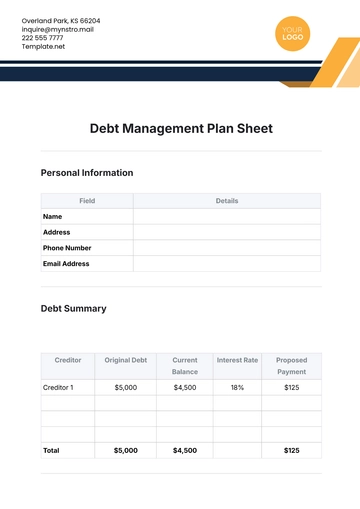Free Finance Long-Term Credit Plan

Executive Summary
Overview of Credit Management Strategy
Our long-term credit management strategy is designed to optimize the balance between risk and opportunity. Key objectives include maintaining a healthy cash flow, minimizing bad debt losses, and supporting sales growth. We aim to achieve this by implementing robust credit assessment processes, regular monitoring, and dynamic policy adjustments in response to market changes. Anticipated challenges include evolving economic conditions, varying customer creditworthiness, and regulatory changes. Our goal is to enhance financial stability and shareholder value through effective credit management.
Financial Health Snapshot
The current financial health of the company is summarized in the table below:
Financial Metric | Current Value | Industry Benchmark |
Liquidity Ratio | 2.0 | 1.5 |
Debt-to-Equity Ratio | 0.6 | 0.8 |
Current Credit Rating (S&P) | AA- | - |
Net Profit Margin | 15% | 12% |
Accounts Receivable Turnover | 45 days | 60 days |
Our strong liquidity ratio and lower-than-industry debt-to-equity ratio indicate a robust financial position. The AA- credit rating reflects a high degree of trust from creditors and investors.
Credit Risk Assessment
Industry and Market Analysis
This section focuses on evaluating the external factors influencing credit risk. Our analysis includes:
Economic Trends: Monitoring GDP growth rates, inflation, and employment statistics to anticipate economic downturns or booms.
Industry-Specific Risks: Analyzing industry reports and market news to identify potential risks, such as regulatory changes or technological disruptions.
Competitor Analysis: Assessing competitors’ credit strategies to benchmark our practices and adjust our risk tolerance.
Client Creditworthiness Evaluation
Our approach to evaluating client creditworthiness is both comprehensive and dynamic. We use a multi-faceted scoring system, which includes:
Financial Analysis: Reviewing clients' financial statements, focusing on profitability, cash flow, and debt levels.
Credit History Check: Examining credit scores, payment histories, and past dealings.
Risk Categorization: Classifying clients into risk categories (low, medium, high) based on their overall score.
The following table outlines our credit scoring system:
Criteria | Weightage | Scoring Range |
Profitability | 30% | 1-10 |
Cash Flow Stability | 25% | 1-10 |
Debt Levels | 20% | 1-10 |
Credit Score | 15% | 1-10 |
Past Payment History | 10% | 1-10 |
Clients are required to achieve a minimum score of 6 to be considered for credit. This score is regularly updated based on ongoing financial performance and market conditions.
Credit Policy Framework
Credit Terms and Conditions
The credit terms and conditions form the backbone of our credit management strategy. These terms are designed to balance risk while providing flexibility to our customers. Key aspects include:
Payment Terms: Standard payment terms are Net 30 days. However, for high-value clients or those with excellent credit history, we offer extended terms up to Net 60 days.
Interest Rates: Interest on overdue accounts is set at 2% per month, but this is subject to change based on prevailing market rates.
Invoicing Procedures: Invoices are issued immediately upon delivery of goods or services, and reminders are sent 7 days before the due date.
The following table outlines our standard credit terms:
Criteria | Standard Condition | Condition for Preferred Clients |
Payment Terms | Net 30 days | Up to Net 60 days |
Interest on Overdue | 2% per month | 1.5% per month |
Invoice Issue Frequency | Upon delivery | Upon delivery |
Reminder Frequency | 7 days before due | 10 days before due |
Credit Limits and Approvals
Our policy stipulates clear guidelines for setting credit limits and the approval process. The credit limit is determined based on the client’s financial stability, credit score, and historical transaction volume with our company.
Initial Credit Assessment: New clients undergo a rigorous financial review, and an initial credit limit is set.
Periodic Review: Existing clients have their credit limits reviewed annually or in response to significant changes in their credit profile.
Approval Hierarchy: Credit limits up to $50,000 are approved by the Credit Manager, while limits above $50,000 require approval from the Finance Director.
The procedure for setting and approving credit limits is summarized in the table below:
Client Category | Initial Credit Limit | Review Frequency | Approval Authority |
New Clients | Based on assessment | Annually | Credit Manager |
Regular Clients | Up to 20% increase | Bi-annually | Credit Manager |
High-Value Clients | Customized | Quarterly | Finance Director |
Clients with Changes | Reassessment Needed | As needed | Depending on Limit Amount |
Credit Monitoring and Reporting
Ongoing Credit Monitoring Procedures
Continuous credit monitoring is vital to identifying potential risks early and taking appropriate action. Our approach includes:
Regular Account Reviews: Conducting monthly reviews of all accounts to identify any changes in payment patterns or financial status.
Automated Alerts: Utilizing software that triggers alerts for overdue accounts or significant changes in credit scores.
Customer Communication: Regularly engaging with customers to understand their current financial situation, especially for accounts showing signs of distress.
The procedure for ongoing credit monitoring is outlined below:
Activity | Frequency | Description |
Account Payment Pattern Review | Monthly | Analyze changes in payment timings and amounts |
Credit Score Update Check | Quarterly | Review any significant changes in credit scores |
Overdue Account Alerts | As Occurred | Immediate notification for overdue accounts |
Reporting Structure
Our reporting structure ensures timely and accurate information flow to relevant stakeholders. Key reports include:
Monthly Credit Report: Summarizes the status of all credit accounts, highlighting any accounts in arrears or at risk.
Quarterly Risk Analysis Report: Provides a more in-depth analysis of the credit portfolio, identifying trends and potential risk areas.
The reporting format is detailed in the table below:
Report Type | Frequency | Contents |
Monthly Credit Report | Monthly | Account status, overdue accounts |
Quarterly Risk Analysis | Quarterly | Trend analysis, risk identification |
Annual Credit Performance | Annually | Yearly performance, policy effectiveness |
Delinquency Management
Early Warning Indicators
Early identification of potential delinquency is crucial. We monitor several indicators:
Payment Delays: Repeated delays in payments, even if within the credit term.
Reduced Order Volume: A significant drop in order volume can indicate financial distress.
External Information: Negative news or credit rating downgrades.
Delinquency Handling Procedures
Our procedures for managing delinquencies are designed to be firm yet fair, with the aim of recovering dues while maintaining customer relationships.
First Reminder: Sent immediately after a payment becomes overdue.
Follow-up Communication: Personalized communication for high-value or at-risk clients.
Payment Plans: Offering structured payment plans for clients facing temporary financial difficulties.
Legal Action: As a last resort, for accounts that remain delinquent despite repeated efforts.
The delinquency management process is summarized in the following table:
Stage | Action | Timeframe |
Payment Overdue | First Reminder Sent | 1-7 days overdue |
Continued Non-Payment | Personal Follow-up | 14 days overdue |
Significant Delinquency | Payment Plan Discussion | 30 days overdue |
Extreme Cases | Legal Action Consideration | 60 days overdue |
Compliance and Regulatory Requirements
Regulatory Compliance
Our credit management practices strictly adhere to relevant regulatory requirements to ensure legal compliance and ethical standards. Key focus areas include:
Data Protection Laws: Compliance with regulations like GDPR for handling customer financial data.
Credit Reporting Standards: Adherence to the standards set by credit reporting agencies and financial authorities.
Anti-Money Laundering (AML) Regulations: Implementing procedures to prevent money laundering activities.
The compliance checklist is outlined in the following table:
Regulation Type | Compliance Measure | Review Frequency |
Data Protection | Encryption, Access Control, Data Minimization | Bi-annually |
Credit Reporting | Accuracy in Reporting, Timely Updates | Quarterly |
AML | Transaction Monitoring, Reporting Suspicious Activity | As needed |
Internal Audits and Controls
To ensure continuous compliance and effective credit management, we have established a robust system of internal audits and controls:
Regular Audits: Conducted semi-annually to review credit processes and compliance.
Control Mechanisms: Including separation of duties, authorization requirements, and documentation standards.
A summary of our internal audit and control framework is presented below:
Audit/Control Type | Description | Frequency |
Compliance Audit | Review of adherence to legal regulations | Semi-annually |
Process Efficiency Audit | Assessment of credit process efficiency | Annually |
Risk Management Audit | Evaluation of risk assessment measures | Annually |
Technology and Infrastructure
Credit Management Systems
We leverage advanced technology systems to enhance our credit management capabilities. These systems include:
Credit Scoring Software: For automated credit scoring based on predefined parameters.
Customer Relationship Management (CRM) Systems: Integrating credit information with customer profiles.
Analytics Tools: For trend analysis and risk prediction.
The key components of our technology infrastructure are detailed in the table below:
System Type | Functionality | Update Frequency |
Credit Scoring Software | Automated credit assessment and scoring | Quarterly |
CRM System | Integration of credit data with customer information | Bi-annually |
Analytics Tools | Risk analysis and reporting | Monthly |
Infrastructure Requirements
Our credit management infrastructure includes both technological and physical components:
Data Security Infrastructure: Robust cybersecurity measures to protect sensitive credit information.
Communication Tools: Efficient systems for internal and external communication regarding credit matters.
Training Facilities: For ongoing staff training on new credit policies and technologies.
Infrastructure requirements are summarized as follows:
Infrastructure Component | Description | Maintenance/Upgrade Schedule |
Data Security | Firewalls, Encryption, Access Controls | As needed |
Communication Systems | Email, Telephony, Conference Tools | Annually |
Training Facilities | On-site and virtual training environments | Bi-annually |
Financial Projections and Analysis
Revenue Impact Analysis
This section delves into how our credit management strategies are projected to influence revenue streams. Key components of this analysis include:
Cash Flow Projections: Estimating the impact of credit terms on cash flow.
Bad Debt Projections: Assessing the potential for bad debt under various scenarios and its impact on net income.
Sales Growth Forecasts: Analyzing how flexible credit terms can potentially increase sales volumes.
The projected financial impact is summarized in the table below:
Year | Projected Cash Flow | Estimated Bad Debt | Projected Sales Growth |
1 | $50 million | $2 million | 5% |
2 | $55 million | $2.5 million | 6% |
3 | $60 million | $3 million | 7% |
Financial Tables
We provide detailed financial tables to illustrate the expected financial outcomes under the new credit plan. These include:
Projected Profit and Loss Statements: Showing the expected revenue and expenses, including the cost of credit.
Balance Sheet Projections: Indicating the impact on assets and liabilities.
Cash Flow Statements: Highlighting the changes in cash flows due to credit policy adjustments.
Projected Profit and Loss Statement:
Year | Total Revenue | Total Expenses | Net Profit |
1 | $100 million | $45 million | $55 million |
2 | $110 million | $50 million | $60 million |
3 | $120 million | $55 million | $65 million |
Balance Sheet Projections:
Year | Total Assets | Total Liabilities | Equity |
1 | $200 million | $100 million | $100 million |
2 | $220 million | $110 million | $110 million |
3 | $240 million | $120 million | $120 million |
Cash Flow Statements:
Year | Operating Cash Flow | Investing Cash Flow | Financing Cash Flow | Net Increase in Cash |
1 | $30 million | -$10 million | $5 million | $25 million |
2 | $35 million | -$12 million | $7 million | $30 million |
3 | $40 million | -$15 million | $10 million | $35 million |
These financial tables are regularly updated to reflect changes in market conditions and company performance.
Review and Revision Procedures
Periodic Review Schedule
To ensure our credit policies remain effective and relevant, we have established a schedule for periodic reviews:
Annual Policy Review: To assess the overall effectiveness of the credit policy and make necessary adjustments.
Semi-Annual Market Analysis: To adjust credit strategies based on market dynamics.
The review schedule is as follows:
Review Type | Frequency | Main Focus Areas |
Credit Policy Review | Annually | Policy effectiveness, compliance, risk assessment |
Market Analysis | Semi-Annually | Market trends, economic conditions, client feedback |
Feedback and Continuous Improvement
We have established mechanisms to gather feedback and facilitate continuous improvement in our credit management practices:
Client Surveys: Regular surveys to gather feedback from clients on our credit processes.
Employee Feedback: Inputs from staff involved in the credit management process.
Benchmarking Studies: Comparing our practices with industry standards and best practices.
Feedback and improvement initiatives are summarized in the following table:
Feedback Source | Frequency | Purpose |
Client Surveys | Quarterly | Assess client satisfaction and suggestions |
Employee Input | Bi-annually | Gather internal feedback and ideas |
Benchmarking | Annually | Compare with industry standards |
- 100% Customizable, free editor
- Access 1 Million+ Templates, photo’s & graphics
- Download or share as a template
- Click and replace photos, graphics, text, backgrounds
- Resize, crop, AI write & more
- Access advanced editor
Strategize your credit operations for the future with the Finance Long-Term Credit Plan Template from Template.net. This editable, customizable template provides a framework for developing long-term credit strategies. Ideal for financial planners, it aids in forecasting, risk assessment, and policy development, ensuring sustainable and profitable credit management.
You may also like
- Finance Plan
- Construction Plan
- Sales Plan
- Development Plan
- Career Plan
- Budget Plan
- HR Plan
- Education Plan
- Transition Plan
- Work Plan
- Training Plan
- Communication Plan
- Operation Plan
- Health And Safety Plan
- Strategy Plan
- Professional Development Plan
- Advertising Plan
- Risk Management Plan
- Restaurant Plan
- School Plan
- Nursing Home Patient Care Plan
- Nursing Care Plan
- Plan Event
- Startup Plan
- Social Media Plan
- Staffing Plan
- Annual Plan
- Content Plan
- Payment Plan
- Implementation Plan
- Hotel Plan
- Workout Plan
- Accounting Plan
- Campaign Plan
- Essay Plan
- 30 60 90 Day Plan
- Research Plan
- Recruitment Plan
- 90 Day Plan
- Quarterly Plan
- Emergency Plan
- 5 Year Plan
- Gym Plan
- Personal Plan
- IT and Software Plan
- Treatment Plan
- Real Estate Plan
- Law Firm Plan
- Healthcare Plan
- Improvement Plan
- Media Plan
- 5 Year Business Plan
- Learning Plan
- Marketing Campaign Plan
- Travel Agency Plan
- Cleaning Services Plan
- Interior Design Plan
- Performance Plan
- PR Plan
- Birth Plan
- Life Plan
- SEO Plan
- Disaster Recovery Plan
- Continuity Plan
- Launch Plan
- Legal Plan
- Behavior Plan
- Performance Improvement Plan
- Salon Plan
- Security Plan
- Security Management Plan
- Employee Development Plan
- Quality Plan
- Service Improvement Plan
- Growth Plan
- Incident Response Plan
- Basketball Plan
- Emergency Action Plan
- Product Launch Plan
- Spa Plan
- Employee Training Plan
- Data Analysis Plan
- Employee Action Plan
- Territory Plan
- Audit Plan
- Classroom Plan
- Activity Plan
- Parenting Plan
- Care Plan
- Project Execution Plan
- Exercise Plan
- Internship Plan
- Software Development Plan
- Continuous Improvement Plan
- Leave Plan
- 90 Day Sales Plan
- Advertising Agency Plan
- Employee Transition Plan
- Smart Action Plan
- Workplace Safety Plan
- Behavior Change Plan
- Contingency Plan
- Continuity of Operations Plan
- Health Plan
- Quality Control Plan
- Self Plan
- Sports Development Plan
- Change Management Plan
- Ecommerce Plan
- Personal Financial Plan
- Process Improvement Plan
- 30-60-90 Day Sales Plan
- Crisis Management Plan
- Engagement Plan
- Execution Plan
- Pandemic Plan
- Quality Assurance Plan
- Service Continuity Plan
- Agile Project Plan
- Fundraising Plan
- Job Transition Plan
- Asset Maintenance Plan
- Maintenance Plan
- Software Test Plan
- Staff Training and Development Plan
- 3 Year Plan
- Brand Activation Plan
- Release Plan
- Resource Plan
- Risk Mitigation Plan
- Teacher Plan
- 30 60 90 Day Plan for New Manager
- Food Safety Plan
- Food Truck Plan
- Hiring Plan
- Quality Management Plan
- Wellness Plan
- Behavior Intervention Plan
- Bonus Plan
- Investment Plan
- Maternity Leave Plan
- Pandemic Response Plan
- Succession Planning
- Coaching Plan
- Configuration Management Plan
- Remote Work Plan
- Self Care Plan
- Teaching Plan
- 100-Day Plan
- HACCP Plan
- Student Plan
- Sustainability Plan
- 30 60 90 Day Plan for Interview
- Access Plan
- Site Specific Safety Plan





























